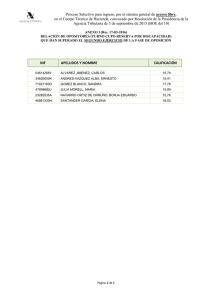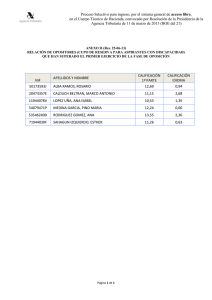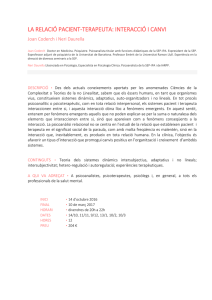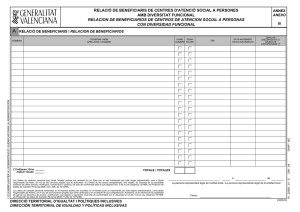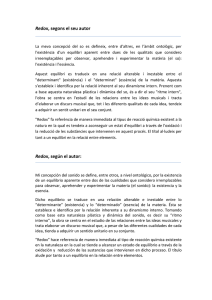Implicacions de la sordesa en l`autoconcepte a l`etapa de l
Anuncio
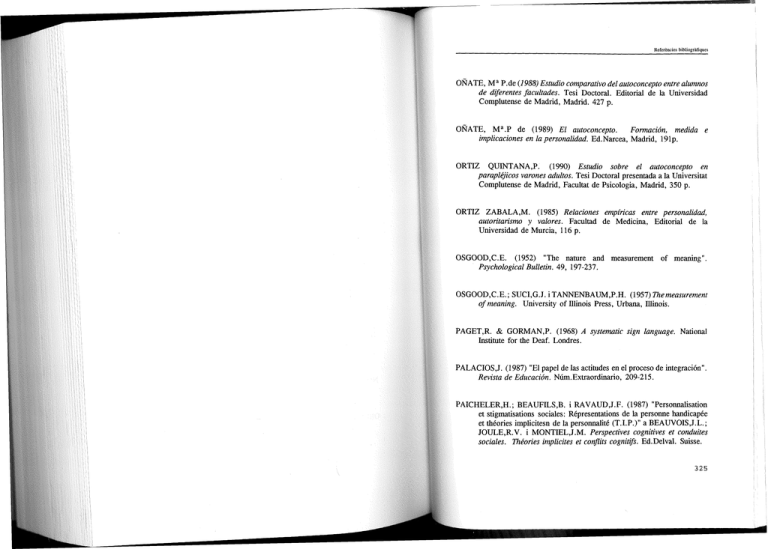
Referències bibliogràfiques OÑATE, M a P.de (1988) Estudio comparativo del autoconcepto entre alumnos de diferentes facultades. Tesi Doctoral. Editorial de la Universidad Complutense de Madrid, Madrid. 427 p. OÑATE, M a .P de (1989) El autoconcepto. Formación, medida e implicaciones en la personalidad. Ed.Narcea, Madrid, 191p. ORTIZ QUINTANA,P. (1990) Estudio sobre el autoconcepto en parapléjicos varones adultos. Tesi Doctoral presentada a la Universitat Complutense de Madrid, Facultat de Psicologia, Madrid, 350 p. ORTIZ ZABALA,M. (1985) Relaciones empíricas entre personalidad, autoritarismo y valores. Facultad de Medicina, Editorial de la Universidad de Murcia, 116 p. OSGOOD,C.E. (1952) "The nature and measurement of meaning". Psychological Bulletin. 49, 197-237. OSGOOD,C.E.; SUCI,G. J. i TANNENBAUM,P.H. (1957) The measurement of meaning. University of Illinois Press, Urbana, Illinois. PAGET,R. & GORMAN,P. (1968) A systematic sign language. National Institute for the Deaf. Londres. PALACIOS,!. (1987) "El papel de las actitudes en el proceso de integración". Revista de Educación. Num.Extraordinario, 209-215. PAICHELER,H.; BEAUFILS,B. i RAVAUDJ.F. (1987) "Personnalisation et stigmatisations sociales: Representations de la personne handicapée et theories implicitesn de la personnalité (T.I.P.)" a BEAUVOISJ.L.; JOULE,R.V. i MONTIELJ.M. Perspectives cognitives et conduites sociales. Theories implícites et conflits cognitifs. Ed.Delval. Suisse. 325 Referències bibliogràfiques PARKER,R.D. (1969) Readings in social development. Holt, Rinehart, Winston, N. Y. PEPITONE,A. (1968) "An experimental analysis of self-dynamics" a GORDON,C. i GERGEN,KJ. The self in social interaction, vol.t:Classic and contemporary perspectives. Wiley, New York, 347-54. PffiRS,E.V. iHARRIS,D.B. (1964) "Age and other correlates of self-concept in children". Journal of Educational Psychology. 55 (2), 91-95. POTTEBAUM,S.M.; KEITH,T.Z. i EHLY,S.W. (1986) "Is there a causal relation between self-concept and academic achievement?. Journal of Educational Research. 79(3), 140-144. POWERS,S.(1990) "Self-perceived competences of a group of hearing-impaired pupils in a unit setting". The Journal of the British Association of Teachers of the Deaf. 14 (3), 61-68. PURKEY,W.W. (1970) Self-concept and school achievement. Prentice-Hall, Englewood Cliffs,NJ. PURKEY,W.W. i CAGE,B.N. (1973) "The Florida key: a scale to infer learner self-concept". Educational and Psychology Measurement. 33, 979-984. PURKEY,W.W. i NOVAK,J.M. (1984) Inviting school success. A self concept approach to teaching and learning. Belmont, California: Wadworth. RAMSPOTT,A. (1991) La comprensión y producción de cuentos en niños y adolescentes sordos. Tesi Doctoral. Dpt. Filologia Espanyola. Facultat de Lletres. Universitat Autònoma de Barcelona. 326 Referències bibliogràfiques REICH,C.;HAMBLETON,D. i HOULDIN,B.K. (1977) "The integration of hearing-impaired children in regular classrooms". American Annals of the Deaf. 122,534-543. ROOD A,M. (1969) Social adjustment of deaf adolescence. North Regional Association for Deaf. n°3, Manchester. RODRIGUEZ TOME,H. (1972) Le moi et I'autre dans la conscience de l'adolescent. Delachaux & Niestlé, Paris. ROGERS,C. (1951) Client-Centered Therapy. Houghton Mifflin. Boston. ROGERS,C. (1982) A social psychology of schooling. Routledge & Kegan Paul,London. ROSENBERG,M. (1965) Society and the Adolescent Self-image. Princeton University Press, Princeton, New Jersey. ROSENBERG,M. (1979) Conceiving the self. Basic Books, N.Y. ROSENBERG,M. (1986) "Self-concept from middle childhood through adolescence". A SULS,J. i GREENWALD,A. Psychological Perspectives on the self. 3, 107-131. Hillsdale, N.J.: Lawrence Erlbaum. RUBIN.D i YUST,B. (1983) "Identity issues and deaf adolescents". Readings in deafness. 9, 192-199. SARBIN,T.R. (1954) "Role theory" a LINDZEY,G. Handbook of social psychology. Vol I, Addison-wesley, Reading, Massachusetts, 223-58. 327 •'t Referències bibliogràfiques SARFATY,L. iKATZ,S. (1978) "The self-concept and adjustment patterns of hearing-impaired pupils in different school settings". American Annals of the Deaf. 123 (4), 43 8-441. SAVARY,M. (1983) "Au colloque sur l'intégration scolaire des enfants et adolescents sourds". Readaptation. Insertion Scolaire Professionnelle Sociale des sourds. 305, p.53. SHATTUCK,M. (1946) "Segregation versus non-segregation of exceptional children". Exceptional Children. 32, 443-450. SCHLESINGER,H.S. i MEADOW,K.P. (1972) Sound and sign: childhood deafness and mental health. Berkeley, C A: University of California Press. SCHEINJ. (1968) The deaf comunity: studies in the social psychology of deafness. Gallaudet College Press. Washington. SCHROEDELJ. & SCHIFF,W. (1972) "Attitudes towards deafness among several deaf and hearing populations". Rehabilitation Psychology. 19, 57-70. SELLERJ. & CHIPMAN,A. (1964) "Factorial structure and correlates of the attitudes towards disabled persons scales". Educational and Psychological Measurement. 24, 831-840. SERRA,M. (1982) "Comunicación, pensamiento y lenguaje en el sordo profundo: revisión y perspectivas". Revista de Logopèdia y Fonoaudiología. 2 (1), 17-26. SHAVELSON,R.J.; HUBNER,J.J. i STANTONJ.C. (1976) "Self-concept: validation of construct interpretations". Review of Educational Research. 46 (3), 407-441. 328 Referències bibliogràfiques SILVESTRE,N. (1985) La comunicació social del nen sord amb el seu company d'edat oient: estratègies comunicatives. Tesi Doctoral presentada a la Facultat de Filosofia i Lletres de la Universitat Autònoma de Barcelona, Bellaterra. SILVESTRE,N. (1988) "El niño con déficit auditivo". Enciclopedia Práctica de Pedagogía. Grupo Ed.Planeta. 6, 320-336. SILVESTRE,N. (1990) A study of the Spanish deaf adolescent's psychological development. 17th International Congress on Education of the Deaf. Rochester, New York, USA. 29 juliol-3 agost. SNYGG,D. i COMBS,A.W. (1949) Individual behaviour: a new frame of reference for psychology. Harper, N.York. STAINES,J.W. (1958) "The self picture as a factor in the classroom". British Journal of Educational Psychology. 28, 97-111. STEINER,G. (1969) "The language animal". Encounter. 33, 7-24. STINSON,M.S.; CHASE,K. i KLUWIN,T. (1990) Self-perceptions of social relationship in hearing-impaired adolescents. Paper presented at the convention of the American Educational Research Association. Boston, MA. STINSON,M.S. i WHITMIRE,K. (1991) "Self-perceptopns of social relationships among hearing-impaired adolescents in England". The Journal of the British Association of Teachers of the Deaf. 15 (4), 104-114. 329 Referències bibliogràfiques STRANG,L.; SMITH,M.D i ROGERS,C.M. (1978) "Social comparison, multiple reference groups, and the self-concepts of academically handicapped children before and after mainstreaming". Journal of Educational Psychology. 70 (4), 487-497. STUART,A.; HARRISON,D. i SIMPSON,?. (1991) "The social and emotional development of a population of hearing-imapired children being educated in their local, mainstream schools in Leicestershire, England". Journal of the British Association of Teachers of the Deaf. 15 (5), 121-125. SULLIVAN,H.S. (1953) The interpersonal theory of psychiatry. Norton, N.Y. SUPER,D.E. (1963) "Toward making self-concept theory operational", a SUPER i al. Career development: self-concept theory. College Entrance Examination Board, New York, 17-32. SUSSMAN,A.E. (1973) An investigation into the relationship between the self concepts of deaf adults and their perceived attitudes toward deafness. Unpublished Doctoral Dissertation, N.Y. University. SCHWARTZJ.L.; ROSS,L.J.; HOUCHINS,R.R. (1975) "An investigation of the self-concept of expressive language of thirty adolescent hearing impaired students using the Q-Sort technique". American Annals of the Deaf. 120, 572-577. THOMAS,A i CHESS,S. Brunner/Mazel, N.Y. (1977) Temperament and development. VALERO,! (1993) "Los elementos facilitadores de la comprensión oral empleados por el profesor del aula regular con adolescentes sordos". Comunicación, Lenguaje y Educación. 18, 101-113. 330 Referències bibliogràfiques VALERO,!. (1994) Les estratègies d'interacció del professor amb l'alumne sord a l'aula regular. Criteris per a la seva optimització. Tesi Doctoral presentada al Departament de Psicologia de l'Educació. Facultat de Psicologia. UAB. VERNON,P.E. (1950) The structure of human abilities. London: Methuen. VILLA,A. i AUZMENDI,E. (1992) Medición del autoconcepto en la edad infantil (5-6años). Dpto. de Investigación y Evaluación Educativa, ICE de la Universidad de Deusto. Ed. Mensajero, Bilbao. WARNOCK Report. Great Britain. Parliament. House of Commons. (1978) Special Education Needs. Report of the Committee of Inquiry into Education of Handicapped children and Young People. London. HMSO. WARREN,C. i HASENSTAB,S. (1986) "Self concept of severely to profoundly hearing-impaired children". The Volta Review. 88 (6), 289-295. WATTS,WJ. (1979) "Deaf children and some emotional aspects of learning". The Volta Review. 81 (7), 491-500. WEINBERG,N. i STERRIT,M. (1986) "Disability and identity: a study of identity patterns in adolescents with hearing impairments". Rahabilitation Psychology. 31, 95-102. WELLS,L.E. i MARWELL,G. (1976) Self-esteem: its conceptualization and measurement. C A.: Sage Publications, Beverly Hills. WOOD,DJ. (1983) "El desarrollo lingüístico y cognitivo en los deficientes auditivos". Infancia y Aprendizaje. 3, 201-222. 331 Referències bibliogràfiques WOOD,D.J.; WOOD,H.; GRIFFITHS,A.; HOWARTHJ. (1987) Teaching and talking with deaf children. John Wiley & Sons. Chichester. WRIGHT, W.K. (1982) "A study of self-concept of hearing-impaired students as compared to the self-concept of normal-hearing students". Dissertation Abstracts International. 42 (12), 5074-A. WYLIE,R.C. (1961) The self-concept. Lincoln: University of Nebraska Press. WYLIE,R.C. (1974) The self-concept, Vol I: A review of methodological considerations and measuring instruments. University of Nebraska Press, Lincoln. WYLDE,R.C. (1979) The self-concept. Theory and research on selected topics. University of Nebraska Press. Revised Edition. Vol.2 Lincoln. YACHNIK,M. (1986) "Self-esteem in deaf adolescents". American Annals of the Deaf. 131, 305-310. ZELLER,M. (1973) The social self. Pergamon Press, New York. ZUMALABEJ.M. (1990) "La psicología de la personalidad y las teorías cognitivas y del procesamiento de la información". Revista de Psicología General y Aplicada. 43, 225-231. ZWD3BEL,A.; MEADOW-ORLANS,K.P. i DYSSEGAARD,B. (1986) "A comparison of hearing-impaired students in Israel, Denmark, and the United States". International Journal of Rehabilitation Research. 9 (2), 109-118. 332 ANNEX 333 INDEX DE L'ANNEX Pag * Descripció de les variables 1 * Imatge per l'expressió oral 2 * Conte "El pou sense final" 3 * Preguntes de comprensió 4 * Models per la situació interactiva 5 * Relació comprensió oral del sord - grau de pèrdua auditiva 6 * Relació sord "receptor"- pèrdua auditiva 6 * Informe escrit obert: "Qui sóc jo?" 7 * Informe escrit semiobert: "Completar 5 frases" 8 * Escala d'identitat 9 * Escala d'autoconcepte 10 * Escala d'actitud pels companys oients del sord 12 * Diferencial Semàntic per valorar la imatge social de la sordesa 15 IDENTITAT DEL SORD , * Habilitat de l'escala d'identitat 16 * Relació grau de pèrdua auditiva-I2:"nou amic, dic ràpid que sóc sord" 18 Relació edat-I9:"important tenir amics oients i sords" 18 Relació pares sords/mixte-I4:"semblo més a oients" 19 Relació expressió oral-I6: "igual casar-me amb sord que oient" 19 Relació comprensió oral-I6:"igual casar-me amb sord que oient" 20 * Relació comprensió oral-Ill:"sols treballaré amb sords" 20 * Relació sord receptor-I3:"dóna igual treballar amb sords que oients" 21 * Relació sord locutor-Ill:"sols treballaré amb sords" 21 AUTOCONCEPTE DEL SORD * Fiabilitat de l'escala d'autoconcepte 22 * Relació pèrdua auditiva-126:"normalment, no faig bé les coses" 25 * Relació sord "reparador"-126: "normalment, no faig bé les coses" 25 * Relació sord receptor-126:"normalment, no faig bé les coses" 26 * Relació sord receptor-I9: "parts del meu cos no m'agraden" 26 * Relació sord "reparador"-I16: "ningú no m'estima" 27 * Relació comprensió oral-I3: "problema no demano ajuda" 27 * Relació pèrdua auditiva-I2:"sóc guapo" 28 * Relació sord "reparador"-I2:"sóc guapo" 28 * Relació pares sords/mixte-I23:"vull tenir més amics oients" 29 * Relació comprensió oral-I18:"tinc més coses dolentes que bones" 29 * Relació comprensió oral-I5:"vull tenir amics sords a classe" 30 * Relació comprensió oral-I10:"a la gent no agrada estar amb mi" 30 * Relació expressió oral-I10:"a la gent no agrada estar amb mi" 31 * Relació pèrdua auditiva-Il9¡"normalment, tinc bones notes" 31 * Relació sord "receptor"-I19: "normalment, tinc bones notes" 32 Relació sord locutor-Il:"em costa estudiar" 32 Relació edat-categories "qui sóc jo" . 33 Relació pèrdua auditíva-trets de personalitat negatius 33 * Relació pèrdua auditiva-referències a la sordesa 34 * Relació pèrdua auditiva-referències a les amistats 34 * Relació competència comunicativa-trets de personalitat negatius 35 * Relació competència lingüística-trets de personalitat negatius 36 ACTITUD DELS COMPANYS OIENTS DE L'AULA * Habilitat de l'escala d'actitud dels oients 38 * Descripció de la variable edat 40 * Relació gènere del sord-I3:"assistència afavorirà aprenentatges" 41 * Relació gènere del sord-Il 1: "agradaria tenir company sord a classe" 41 * Relació expressió oral del sord-I3:"assistència afavorirà aprenentatges" 42 * Relació expressió oral del sord-I7:"company sord molt positiu" 43 * Relació expressió oral del sord-I6:"aprendran més a escola especial" 44 * Relació comprensió oral del sord-I6: "aprendran més a escola especial" 45 * Relació comprensió oral del sord-I9:"es trobarà sol a classe" 46 * Relació sord "receptor"-13: "assistència afavorirà aprenentatges" 47 * Relació sord "receptor"-17¡"company sord molt positiu" 48 * Relació sord locutor-Il:"escola especial millors atencions" 49 * Relació sord locutor-Il7: "resulta difícil parlar amb sord" 50 * Relació sord locutor-I9:"es trobarà sol a classe" 51 * Relació sord "reparador"-I9:"es trobarà sol a classe" 52 * Relació sord "reparador"-!! 1: "agradaria tenir company sord a classe" 53 * Anàlisi factorial de l'escala d'actitud 54 Relació comprensió oral del sord-F3: "integració" 56 * Relació sord "reparador"-Fl: "interacció sord-oient" 57 REPRESENTACIÓ SOCIAL DE LA SORDESA * Fiabilitat del Diferencial Semàntic del col·lectiu de cecs 58 * Fiabilitat del Diferencial Semàntic del col·lectiu de sords 59 * Fiabilitat del Diferencial Semàntic del col. persones sense def. sensorial 60 * Relació descriptors de personalitat-coneixement d'una persona sorda 61 Descripció de les variables """ANÀLISI DESCRIPTIU GENERAL. FRE VAR EDAT /STA DEF. EDAT EDAT DEL NOI-A SORD-A Mean Maximum 14.735 19.000 Valid cases Valid Cum Percent Percent Percent Value Frequency Value Label 34 12 13 14 15 16 17 18 19 4 6 7 8 2 2 4 1 Total 34 11.8 17.6 20.6 23.5 5.9 5.9 11.8 2.9 100.0 1.959 Std dev Missing cases 11.8 17.6 20.6 23.5 5.9 5.9 11.8 2.9 11.8 29.4 50.0 73.5 79.4 85.3 97.1 100.0 100.0 Minimum 12.000 0 FRE VAR PERD_AUD SEXE PARES EXP_ORAL TO REPARADO. PERD_AUD PÈRDUA AUDITIVA Valid Cum Value Frequency Percent Percent Percent Value Label P S PROFUNDA SEVERA Valid cases SEXE 34 Total Missing cases 34 58.8 41.2 58.8 41.2 100.0 100.0 58.8 100.0 0 SEXE DEL NOI-A SORD-A Valid Cum Value Frequency Percent Percent Percent Value Label 1 2 DONA HOME Valid cases PARES 20 14 34 Total Missing cases 20 14 34 1 2 Valid cases 34 Total Missing cases 100.0 100.0 58.8 100.0 Valid Cum Percent Percent Percent Value Frequency SORDS/HIXTE OIENTS 58.8 41.2 0 AUDICIÓ DELS PARES Value Label 58.8 41.2 11 23 34 0 32.4 67.6 32.4 67.6 100.0 100.0 32.4 100.0

